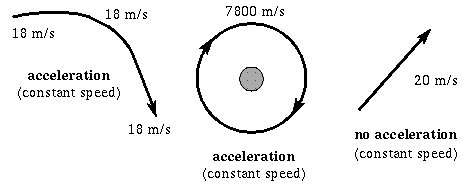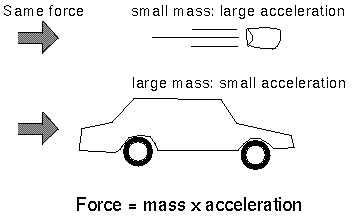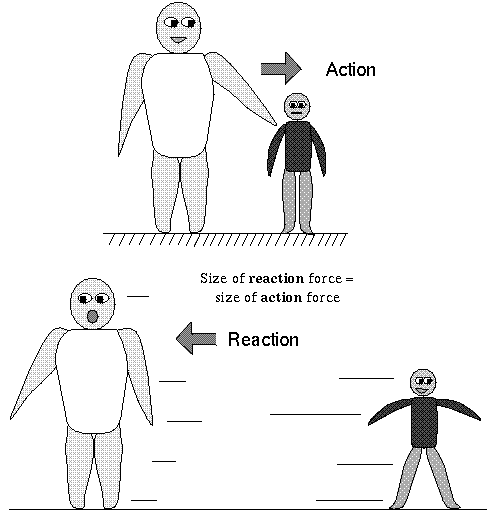Video lecture for this chapter
This material (including images) is copyrighted!.
See my copyright notice for fair use
practices. Select the photographs to display the original source in
another window.
In order to accurately describe how things move, you need to be careful in how
you describe the motion and the terms you use. Scientists are usually very careful
about the words they use to explain something because they want to accurately
represent nature. Language can often be imprecise and as you know, statements can
often be misinterpreted. Because the goal of science is to find the single true
nature of the universe, scientists try to carefully choose their words to accurately
represent what they see. That is why scientific papers can look so ``technical''
(and even, introductory astronomy textbooks!)
When you think of motion, you may first think of something moving at a uniform
speed. The speed = (the distance travelled)/(the time it takes). Because
the distance is in the top of the fraction, there is a direct relation between the
speed and the distance: the greater the distance travelled in a given time, the
greater is the speed. However, there is an inverse relation between time and speed
(time is in the bottom of the fraction): the smaller the time it takes to
cover a given distance, the greater the speed must be.
To more completely describe all kinds of changes in motion, you also need to consider
the direction along with the speed. For example, a ball thrown upward at the
same speed as a ball thrown downward has a different motion. This inclusion of
direction will be particularly important when you look at an object orbiting a planet
or star. They may be moving at a uniform speed while their direction is constantly
changing. The generalization of speed to include direction is called
velocity. The term velocity includes both the
numerical value of the speed and the direction something is moving.
 Galileo conducted
several experiments to
understand how something's velocity can be changed. He found that an object's
velocity can be changed only if a force acts on the object. The philosopher
René Descartes (lived 1596--1650, picture at left) used the idea
of a greater God and an
infinite universe with no special or privileged place to articulate the concept of
inertia: a body at rest remains at rest, and
one moving in a straight line maintains a constant speed and same direction unless
it is deflected by a ``force''. Newton took this as the beginning of
his description of how things move, so this is now known as Newton's 1st law
of motion. A force causes a change in something's
velocity (an acceleration).
Galileo conducted
several experiments to
understand how something's velocity can be changed. He found that an object's
velocity can be changed only if a force acts on the object. The philosopher
René Descartes (lived 1596--1650, picture at left) used the idea
of a greater God and an
infinite universe with no special or privileged place to articulate the concept of
inertia: a body at rest remains at rest, and
one moving in a straight line maintains a constant speed and same direction unless
it is deflected by a ``force''. Newton took this as the beginning of
his description of how things move, so this is now known as Newton's 1st law
of motion. A force causes a change in something's
velocity (an acceleration).
An acceleration is a change in the speed and/or
direction of motion in a given amount of time: acceleration= (the velocity
change)/(the time interval of the change).
Something at rest is not accelerating and something moving at constant speed in
a straight line is not accelerating. In common usage, acceleration usually means
just a change in speed, but a satellite orbiting a planet is
constantly being accelerated even if its speed is constant because its
direction is constantly being deflected. The satellite must be experiencing a force
since it is accelerating. That force turns out to be gravity. If the force (gravity)
were to suddenly disappear, the satellite would move off in a straight line along
a path tangent to the original circular orbit.

A rock in your hand is moving horizontally as it spins around the center of
the Earth, just like you
and the rest of the things on the surface are. If you throw the rock straight up,
there is no change in its horizontal motion because of its inertia. You
changed the rock's vertical motion because you applied a vertical force
on it. The rock falls straight down because the Earth's gravity acts on only
the rock's vertical motion. If the rock is thrown straight up, it does not
fall behind you as the Earth rotates. Inertia and gravity also explain why you do
not feel a strong wind as the Earth spins---as a whole, the atmosphere is spinning
with the Earth.
Newton's first law of motion is a qualitative one---it
tells you when something will accelerate.
Newton went on to quantify the amount of the change that would be observed
from the application of a given force. In
Newton's second law of motion, he said that
the force applied = mass of an object × acceleration.
Mass is the amount of material an object has and is a way
of measuring how much inertia the object has.
For a given amount of force, more massive objects
will have a smaller acceleration than less massive objects (a push needed to even
budge a car would send a pillow flying!). For a given amount of acceleration, the
more massive object requires a larger force than a less massive object.

Newton also found that for every action force ON an object, there
is an equal but opposite force BY the object
(Newton's third law of motion). For example, if Andre
the Giant is stuck on the ice
with Tom Thumb and he pushes Tom Thumb to the right, Andre will feel an equal force
from Tom pushing him to the left. Tom will slide to the right with great speed and
Andre will slide to the left with smaller speed since Andre's mass is larger than
Tom's.

Another example: an apple falls to the Earth because it is
pulled by the force of the Earth's gravity on the apple and the acceleration of the
apple is large. The apple also exerts a gravitational force on the Earth of the
same amount. However, the acceleration the Earth experiences is
vastly smaller
than the apple's acceleration since the Earth's mass is vastly larger than the
apple's---you will ordinarily refer to the apple falling to the Earth, rather than the
Earth moving toward the apple or that they are falling toward each other.
Vocabulary
| acceleration | force | inertia |
| mass | Newton's 1st law |
Newton's 2nd law |
| Newton's 3rd law | velocity |
Formulae
Newton's 2nd law: Force = mass × acceleration: F = m × a
- What 2 things can change for an acceleration?
- If you give a bowling ball a push FAR away from any gravitational effects,
what will it do? If you throw a feather (again far out in space) at the same
speed as the bowling ball, how will its speed compare to the bowling ball
after 5 minutes?
- Let's say you're twirling a ball on a string and the string breaks. What
path does the ball take and why is that?
- How do you know gravity acts on an orbiting satellite?
- How does a force exerted on an object relate to the object's mass or
acceleration? Given the same force will a boulder accelerate more than a
regular marble? Why?
- Why would you need to apply more force to a bowling ball than a feather (far
out in space) so that they
would be traveling at the same speed after 10 minutes?
 Go back to previous section --
Go back to previous section --
 Go to next section
Go to next section
last updated:
February 21, 2022
Is this page a copy of Strobel's
Astronomy Notes?
Author of original content:
Nick Strobel
 Galileo conducted
several experiments to
understand how something's velocity can be changed. He found that an object's
velocity can be changed only if a force acts on the object. The philosopher
René Descartes (lived 1596--1650, picture at left) used the idea
of a greater God and an
infinite universe with no special or privileged place to articulate the concept of
inertia: a body at rest remains at rest, and
one moving in a straight line maintains a constant speed and same direction unless
it is deflected by a ``force''. Newton took this as the beginning of
his description of how things move, so this is now known as Newton's 1st law
of motion. A force causes a change in something's
velocity (an acceleration).
Galileo conducted
several experiments to
understand how something's velocity can be changed. He found that an object's
velocity can be changed only if a force acts on the object. The philosopher
René Descartes (lived 1596--1650, picture at left) used the idea
of a greater God and an
infinite universe with no special or privileged place to articulate the concept of
inertia: a body at rest remains at rest, and
one moving in a straight line maintains a constant speed and same direction unless
it is deflected by a ``force''. Newton took this as the beginning of
his description of how things move, so this is now known as Newton's 1st law
of motion. A force causes a change in something's
velocity (an acceleration).


